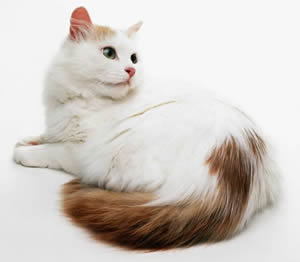Breed Standard
Head: Medium to large in size, at least as long as it is wide. Rounded contours. No angles or straight lines. High cheekbones. Full, rounded muzzle. Nose with slight stop, then delicately hooked. Considerable whisker pinch. Slightly rounded chin.
Eyes: Large, shaped like a walnut or peach pit, set slightly at a slant. Eyelids outlined in pink. Color: blue, amber, or heterochromatic. Green is allowed, but amber is preferred.
Neck: Short and strong.
Body: Long, large, strong. Rounded rib cage. Fairly broad hips. Large-boned, well-developed muscles.
Paw: Moderately long. Hind legs longer than forelegs. Medium-boned, well-muscled. Round paws. Dense tufts of hair between the toes.
Tail: Moderately long, thick, well-furnished, fluffy, or plumed. Hair must be at least 5 cm long. The color is even along the entire tail.
Coat: Semilong to long, soft, silky hair without woolly undercoat. Ruff and britches well-furnished in winter. Pure white coat. Reddish-brown (auburn) or cream symmetrical markings at the base of the ears separated by a white blaze. Another colored patch running from the croup to the tip of the tail. The arrangement of these markings is called a "van" pattern. Main recognized colors: red and white, cream and white.
Fault: More than three colored patches on the body. No blaze on the face. Markings unevenly distributed. Tail color starting too far up the back. Disqualify: bicolor and solid patterns. Absence of coloring on the ears and tail.
History
All white with markings on the head and a lovely colored tail The Turkish Van is a more massive variety of Turkish Angora. It is named for the Lake Van region near Mount Ararat in eastern Turkey. This very old breed was reported as early as the 18th century, but it was not until 1955 that a British breeder named Laura Lushington imported Turkish Vans and truly began breeding them in Europe. The G.C.C.F. and the F.I.Fe. recognized the breed in 1969. By 1982, the Turkish Van arrived in the United States, where the C.F.A. and T.I.C.A. approved it. Nevertheless, this breed is quite uncommon in Europe.
Behavior
This particularly hardy, sturdy, very lively cat loves to swim. Although the breed was once reputed to be aggressive, selective breeding has made Turkish Vans friendly, especially toward other cats. Independent, playful, and with a strong character, they are very affectionate and often possessive toward their owner.
Health
Turkish Vans are a natural breed and generally very healthy cats. There are no genetic problems common to the breed.






